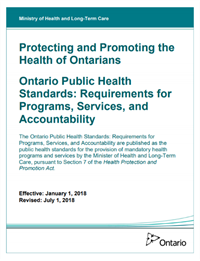Module 4.1: Canadian Public Health StructuresC. Provincial/Territorial Public Health Structures
PROVINCIAL Ministry Structure
The chain of command and broader government structure at the provincial level follows a similar pattern to that of the federal government. There's the Premier and the cabinet, there are the ministers that head each ministry, as well as deputy ministers, and assistant deputy ministers. At a high level, provincial structures might look something like that shown below:
Provincial organizational structure for Ministry of Health.
© Course Author(s) and University of Waterloo
The actual structure of public health in any given province is considerably more complex. Each province or territory has a Chief Medical Officer of Health (CMOH) or its equivalent. In some provinces, the CMOH is by default the head of the public health branch, but not always. In Quebec, for example, the Assistant Deputy Minister is, by law, a physician with a specialist qualification in community medicine. The important relationship between government and CMOH varies. Provinces typically try to balance the desire to ensure the independence of the CMOH as a health advocate with a need to integrate their portfolio into ministries of health. In addition to the CMOH, each province or territory has public health staff within the government. They typically engage in planning, administering budgets, advising on programs, and providing assistance to local staff for serious incidents. Of course, the capacity of these staff varies from province to province.
Example: Provincial Structures
If you would like a detailed breakdown of the ministry and who is in each position in Ontario at present, see Ministry of Health October 2019 organization chart. A few notes to highlight:
- In Ontario, Public Health is housed in the Ministry of Health
- The only elected officials in the Ministry of Health is the Minister of Health, the Associate Minister of Mental Health and Additions, and the Parliamentary Assistant
- Public Health efforts are led by the Chief Medical Officer of Health, Public Health
If you’re interested in the structural profile of Public Health in other provinces, here is a link that shows the structure in all of the provinces and territories: Structural Profile of Public Health in Canada.
Provincial Public Health Authorities
Similar to the purpose of PHAC, several provinces have created provincial models of public health that are noteworthy. These provinces have created autonomous or semi-autonomous public health bodies who have a mandate for public health, funded by the provincial government. Three notable examples include:
Québec

© Gouvernement du Québec 2010
Established the National Public Health Institute (INSPQ) in 1998 by transferring staff from several regional public health departments and from the ministry. INSPQ oversees the main public health laboratories and centres of expertise in Quebec, and have a mandate that covers prevention, health promotion, healthy living, workplace health, and chronic and infectious disease control.
British Columbia

© 2019 Provincial Health Services Authority
In 1997, the British Columbia Centre for Disease Control (BC CDC) to take responsibility for provincial-level management of infectious disease prevention and control, including laboratories. The structure is somewhat different, in that the division directors and other key scientific directors hold appointments at University of British Columbia and have protected time to enable academic activities in addition to their CDC functions. This allows for a particular emphasis on grounding activities on research evidence.
Ontario

© 2019 Ontario Agency for
Health Protection and Promotion
In 2006, Ontario created the Ontario Agency for Health Protection and Promotion, as part of the Ontario Agency for Health Protection and Promotion Act. In 2011, OAHPP adopted the operating name Public Health Ontario.
PHO is primarily funded by the Ministry of Health. They operate public health laboratories, and conduct research in a number of areas in public health relating to:
- infectious diseases
- infection prevention and control
- surveillance and epidemiology
- health promotion, chronic disease and injury prevention
- environmental and occupational health
- emergency preparedness and incident response
Ontario Public Health Standards

Ministry of Health and Long-Term Care. (2018).
In most provinces, execution of public health activities occur at the local level with guidance from the provincial government. In Ontario, this is made explicit through the Ontario Public Health Standards. Developed in 2008 and last revised in 2018, the Ontario Public Health Standards outline the expectations for boards of health which are responsible for providing public health services to Ontarians. The Standards establish required programs and services that the province has deemed essential and as such are required to be addressed by the Boards of Health.
“The Ontario Public Health Standards (OPHS) and Protocols establish the minimum requirements for fundamental public health programs and services to be delivered by Ontario's 36 boards of health, which include assessment and surveillance, health promotion and policy development, disease and injury prevention, and health protection. The OPHS and Protocols are published by the Minister of Health and Long-Term Care, pursuant to Section 7 of the Health Protection and Promotion Act, R.S.O. 1990, c. H.7.”
The Foundational Standards include:
- Population Health Assessment
- Health Equity
- Effective Public Health Practice, which is divided into three sections:
- Program Planning, Evaluation, and Evidence-Informed Decision-Making
- Research, Knowledge Exchange, and Communication
- Quality and Transparency
- Emergency Management
The Program Standards are grouped thematically to address Chronic Disease Prevention and Well-Being; Food Safety; Healthy Environments; Healthy Growth and Development; Immunization; Infectious and Communicable Diseases Prevention and Control; Safe Water; School Health; and Substance Use and Injury Prevention.